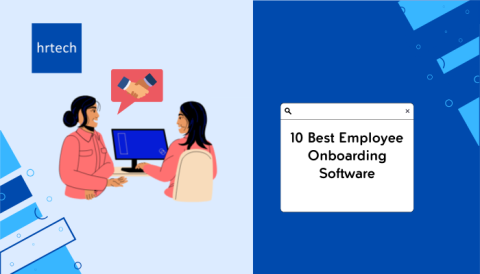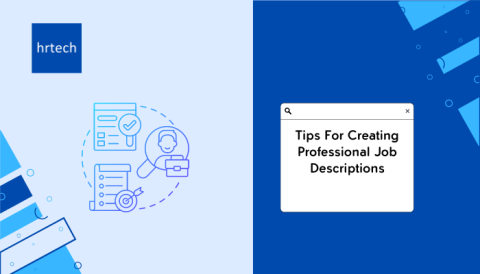Hiring the perfect candidate is difficult—but what’s even more difficult is keeping them in the company for the long haul. HR managers spend weeks sifting resumes, interviewing, and selecting talent, only to watch great hires leave too soon.
Finding the right talent is just half the battle; making new hires feel welcomed, valued, and connected matters just as much. Did you know that 80% of employees who have a poor onboarding experience plan to quit soon? Without proper onboarding, even enthusiastic employees quickly feel disconnected, lose motivation, and start eyeing better opportunities elsewhere.
Could a clear, well-planned onboarding strategy solve these problems? Can onboarding actually build lasting commitment, reduce turnover, and make employees eager to stay?
In this blog, we’ll provide a complete guide to onboarding new employees, from creating a positive first impression to building a process that drives long-term retention.
What is Employee Onboarding?
Onboarding is the process of integrating a new team member into the company and helping them understand its culture and policies. Think of it like boarding a plane: they welcome you, show you to your seat, and make you comfortable for the journey ahead. The goal is to ensure that new hires feel prepared and supported from the start, setting them up for success.
A strong onboarding process should:
- Clarify roles and responsibilities
- Help employees settle into their new environment
- Introduce them to their colleagues
- Teach company policies and procedures
Effective onboarding ensures new employees quickly become productive and confident in their roles. Let’s understand why effective onboarding is important in an organization.
Importance of Effective Onboarding
The first six months are critical for new employees as they form their first impressions of the company. Establishing a clear onboarding process can help them clearly understand the company’s expectations from them.
According to a study by Gallup, employees who have great onboarding experience are 2.6 times more likely to be extremely satisfied at work.
Here’s why effective onboarding is so important:
1. Helps Understand Company’s Culture and Expectations
Onboarding is crucial for introducing new hires to the company’s culture and organizational expectations. The sooner they understand what’s expected, the faster they adapt and become productive. Communicating these cultural norms makes employees feel aligned with the company’s values.
How it works
Here’s how onboarding helps new employees:
- Sharing formal policies and their importance helps set the right tone for employee behavior and decision-making.
- Explaining the organizational structure and communication protocols provides clarity on how teams collaborate.
- Introducing team-specific culture ensures that new hires integrate smoothly into their team and environment.
2. Reduces Time to Become Fully Productive
Onboarding plays a key role in reducing the time it takes for new employees to become fully productive. A well-planned onboarding program provides clarity on job responsibilities, expectations, and success metrics. This process equips them with the tools and knowledge needed to start contributing early.
How it works:
Here’s how good onboarding helps employees become productive faster:
- Providing necessary training and resources accelerates learning, making employees productive sooner.
- Clear role expectations and success metrics reduce confusion and help new hires adapt quickly.
- One-on-one time with managers helps clarify job expectations and responsibilities, making the transition smoother.
3. Helps in Training and Development of the New Hire
Effective onboarding supports ongoing training and sets the foundation for future development. It includes personalized training that equips employees for their specific role. A comprehensive onboarding process helps foster growth by providing mentorship and development opportunities.
How it works:
Here’s how effective onboarding helps you train the new hires:
- Onboarding programs include personalized role-specific training to equip employees with the skills they need.
- Offering mentorship and growth opportunities boosts morale and motivates employees to succeed.
- Providing clear development plans ensures employees have a roadmap for long-term growth and success.
4. Reduces Employee Turnover
A well-executed onboarding process helps reduce early employee turnover. Studies show that poor onboarding increases the likelihood of new hires leaving within the first few months. 68% of the employees leave the organization in the first three months and poor onboarding is a major reason behind this. By investing time and effort into onboarding, businesses can significantly lower turnover rates.
How it works:
Here’s how onboarding experience affects employee turnover:
- New hires who experience poor onboarding are more likely to feel disengaged and leave.
- Positive onboarding experiences create a strong initial connection with the company, encouraging long-term retention.
- Engaging new hires early improves job satisfaction, making them more likely to stay and contribute to the organization.
5. Improves Employee Engagement
A thoughtful approach to onboarding helps improve employee engagement by tailoring the experience to each individual’s learning style. By offering a mix of resources—such as videos, interactive activities, and webinars—employees stay engaged and learn more effectively. Shadowing colleagues or participating in mentoring programs provides real-world insights that go beyond traditional training materials.
How it works:
Here’s how onboarding influences employee engagement:
- Offering various learning methods like video, apps, and animation caters to different learning preferences.
- Shadowing team members or mentoring programs provide hands-on experience and practical knowledge.
- When new hires apply what they’ve learned in real situations, it builds confidence and strengthens their connection to the company.
The employee onboarding process may be costly, however, there are many cost effective solutions. Check out our blog, “Free Employee Onboarding Software with Open Source Features” to learn more.
Let’s now explore the key phases of employee onboarding and how each stage contributes to a smooth and successful integration into the company.
Phases on Employee Onboarding
Employee onboarding is a multi-stage process to integrate new hires into the company smoothly and effectively. While phases of onboarding that an organization follows can widely vary, it is important to ensure a positive onboarding experience. Unfortunately a recent study shows that only 12% of employees strongly agree that their organization did a good job of onboarding new hires.
Ideally there are five main phases of employee onboarding. Each phase plays a critical role in ensuring new employees feel confident, supported, and ready to contribute to the organization’s success.
Here are the key phases of employee onboarding:
Phase 1: Pre-Boarding
Pre-onboarding begins as soon as a new hire accepts the job offer and continues until their first official day. This phase ensures that new employees have all the information and tools they need before starting, helping them feel prepared and excited about their new role.
It’s also a critical time to strengthen their commitment and reduce the risk of them reconsidering their decision.
What it includes:
Here’s what pre-boarding phase includes:
- Documentation: Sending necessary documents to get them set up for their first day.
- Software accounts: Setting up accounts on HR tools and other platforms for easy access.
- Welcome kit: Sending a kit with company swag and handbooks to make them feel welcomed.
- Mentor introduction: Introducing them to a mentor for support from day one.
Phase 2: Orientation and Initial Onboarding
This phase marks the official start of a new hire’s journey, typically occurring on their first day or within the first few days. It’s a time to provide them with an introduction to the company, its culture, and their role. Orientation helps the new hires understand company policies, procedures, and what’s expected from them in their day-to-day tasks.
What it includes:
Initial onboarding and orientation includes:
- Workplace tour: Showing them around the office and key areas.
- Company values and policies: Educating them on the company’s culture, values, and safety protocols.
- Role overview: Explaining the job responsibilities and daily tasks.
- Team introductions: Introducing new hires to their team members and other key individuals.
Phase 3: Training
The training phase is essential for ensuring new hires have the skills and knowledge to perform their jobs effectively. It can span several days or weeks, depending on the complexity of the role. This stage is a vital part of retention, as employees who feel prepared are more likely to stay long-term.
What it includes:
Initial training during onboarding process should include:
- Job-specific training: Providing the necessary skills for their role.
- Team dynamics: Teaching them how to work with others and collaborate effectively.
- Team-building exercises: Activities that promote bonding and relationship-building.
- Cross-functional roles: Introducing other team roles to foster understanding and teamwork.
Phase 4: Mentorship and Early Performance Reviews
Once the new hire is confident in their daily tasks, the focus shifts to long-term growth, mentoring, and performance feedback. This phase helps new employees understand their strengths and areas for improvement, fostering continuous development.
What it includes:
Here’s what mentorship and performance reviews should include:
- Performance metrics: Setting clear goals and expectations for performance.
- Regular feedback: Providing constructive feedback on their work and progress.
- Skill development: Offering opportunities for growth and improvement.
- Mentoring: Pairing the new hire with a mentor for guidance and support.
Phase 5: Continuous Employee Development
Even after the initial onboarding stages, employee development continues to be a priority. This phase ensures that employees don’t feel stagnant in their roles and that they have opportunities for growth. Ongoing support and development are key to employee satisfaction and retention over the long term.
What it includes:
This phase focuses on supporting employees’ growth through ongoing feedback, learning opportunities, and team engagement. Here’s what it includes:
- Continuous Performance Reviews: Regular check-ins to track progress and discuss goals.
- Development Opportunities: Providing access to courses, workshops, and mentorship.
- Skill Building: Encouraging employees to continuously improve their skills and knowledge.
- Teambuilding Activities: Organizing events to strengthen relationships and collaboration.
While it is convenient to break the entire process down into different phases, you should also consider having a proper onboarding checklist. To learn more check out, “Top 12 New Hire Onboarding Templates And Checklists”.
Now that we’ve covered the key phases of onboarding, let’s explore some of the most effective activities. These activities play a crucial role in smoothly integrating the new hires into the organization.
Onboarding Activities
It’s important to focus on key aspects that lay a good foundation for new hires. While we have already observed the key phases of onboarding, from a theoretical standpoint, onboarding should essentially cover five important aspects commonly termed the “5Cs.”
5C’s of onboarding include:
- Clarity
- Compliance
- Culture
- Connection
- Check-in
The onboarding activities that you implement should focus on the 5C’s irrespective of phase of onboarding you’re in. The below table summarizes some important onboarding activities:
| Onboarding Activity | Helps in (The 5C’s) | Objective |
| Welcome kit with essential documents | Clarity and Compliance | Provide new hires with essential information and documents before they start. |
| Introductions and team-building exercises | Connection | Help new employees bond with their team and integrate into the company culture. |
| Role-specific training sessions | Clarity | Equip new hires with the necessary skills and knowledge for their role |
| Mentorship pairing | Connection | Ensure new employees have a go-to person for guidance and support. |
| Feedback sessions and performance reviews | Check-in | Ensure continuous improvement and growth by providing regular performance feedback. |
| Workplace tour | Culture | Introduce the new hire to the physical or virtual workspace and key areas. |
| HR system walkthrough | Clarity | Familiarize the new hire with HR tools and important software systems. |
| Setting up work tools (laptop, software, etc.) | Clarity | Ensure the new hire has all tools, software, and access needed to perform their job. |
| Health and safety orientation | Compliance | Ensure employees are aware of the company’s health and safety policies and protocols. |
You may need to invest time and effort in conducting the above onboarding activities. However, with automation you can make these processes simpler. Learn how to automate onboarding from our blog, “How to Automate HR Onboarding Process”.
Now that we’ve covered key activities, let’s explore how to design an effective onboarding program for new hires.
How to Design an Effective Onboarding Program?
A well-structured program can significantly improve retention, productivity, and overall job satisfaction. When it comes to designing your onboarding program, one size doesn’t fit all. Scope, purpose, resources, and objectives will vary depending on your organization.
We have prepared a simple step-by-step guide to help you create a comprehensive onboarding process.
Step 1: Define Objectives and Set Clear Expectations
Establish the goals and desired outcomes of the onboarding process, ensuring alignment with company objectives.
- Identify key goals: Set objectives such as improving retention, boosting productivity, and fostering cultural fit.
- Align with leadership: Ensure onboarding aligns with broader company goals and team needs.
- Measure success: Use metrics like employee satisfaction, retention rates, and time-to-productivity.
Step 2: Develop a Structured Timeline and Plan
Create a detailed timeline for the entire onboarding process, from pre-onboarding to integration into the team.
- Outline schedule: Create a timeline for the first week, month, and beyond with clear milestones.
- Break into phases: Structure the onboarding into phases such as pre-onboarding, orientation, and training.
- Include key activities: Plan activities like team introductions, training sessions, and performance reviews.
Step 3: Personalize and Prepare Resources
Tailor the onboarding experience to the individual and provide them with all the tools to succeed.
- Assign a mentor: Provide a mentor or buddy to guide the new hire throughout their first few months.
- Set up role-specific training: Prepare role-specific materials and training to equip the new hire for their tasks.
- Prepare work tools: Ensure all equipment, software, and access are ready before day one.
- Provide personalized agenda: Customize the onboarding schedule to include role-specific meetings and check-ins.
Step 4: Foster Social Connections and Integration
Encourage relationship-building to help the new hire feel connected to the team and the company culture.
- Organize team-building activities: Plan ice-breakers and group sessions to build connections among the team.
- Introduce key team members: Ensure new hires meet key colleagues and leadership to understand their roles.
- Schedule casual meetings: Arrange informal meetings like virtual coffee chats to foster team bonding.
Step 5: Regular Check-ins and Continuous Feedback
Ensure ongoing support and feedback to track progress and address any issues early on.
- Schedule regular meetings: Set up weekly or bi-weekly one-on-ones with managers to track progress.
- Provide feedback: Offer constructive feedback and support based on performance.
- Adjust as needed: Use check-ins to assess progress and make improvements to the onboarding process.
Once you have a well-structured onboarding plan in place, the next step is to optimize each phase for maximum efficiency and engagement. Let’s take a look at how to optimize the phases of the onboarding process.
How to Optimize the Employee Onboarding Phases?
Optimizing employee onboarding ensures a smoother transition, faster productivity, and higher retention. By refining each phase with structured processes and engaging tools, companies can enhance the new hire experience.
Here are specific ways to improve onboarding effectiveness:
- Automate administrative tasks: Use HR software like BambooHR or Workday to handle paperwork, compliance training, and IT setup before day one.
- Send personalized preboarding kits: Provide a role-specific welcome package with team introductions, an agenda for the first week, and access to company tools.
- Use a 30-60-90 day roadmap: Define clear learning goals, key tasks, and performance expectations to guide new hires.
- Gamify training modules: Use interactive quizzes, simulations, and scenario-based learning to make role-specific training more engaging and effective.
- Assign an onboarding buddy: Pair new employees with experienced colleagues to answer questions and ease the transition.
- Schedule structured check-ins: Set up weekly 1:1 meetings with managers for the first month to address concerns and track progress.
- Provide hands-on experience early: Introduce small, real tasks within the first week to build confidence and integration.
- Gather real-time feedback: Use pulse surveys or tools to identify pain points and continuously improve onboarding.
Find the best onboarding solutions to plan holistic onboarding programs for your organization. Explore hrtech marketplace today!
Conclusion
Onboarding is a vital process that prepares new hires for success and integrates them into the company. It involves several stages, including pre-onboarding, orientation, training, and continuous development. This blog provides a comprehensive guide to onboarding new employees, covering the phases, key activities, and steps for a successful program.
With comprehensive HR software solutions, hrtech streamlines onboarding and other HR processes. The hrtech marketplace is your one-stop shop for all things HR. You can easily find the best HR software solutions, compare them, and then choose. You can also book an expert consultation to get personalized recommendations..
Discover how hrtech marketplace brings you the best HR onboarding solutions in the market. Book a consultation today!





